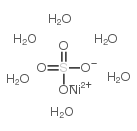nickel sulfate hexahydrate

nickel sulfate hexahydrate structure
|
Common Name | nickel sulfate hexahydrate | ||
|---|---|---|---|---|
| CAS Number | 10101-97-0 | Molecular Weight | 262.84800 | |
| Density | 2,07 g/cm3 | Boiling Point | 2732 °C(lit.) | |
| Molecular Formula | H12NiO10S | Melting Point | 1453 °C(lit.) | |
| MSDS | Chinese USA | Flash Point | N/A | |
| Symbol |



GHS07, GHS08, GHS09 |
Signal Word | Danger | |
|
Variability in patch test reactivity over time, falsely indicating patch test sensitization, in a patient tested with palladium salts.
Contact Dermatitis 67(2) , 109-11, (2012)
|
|
|
Usage test with palladium-coated earrings in patients with contact allergy to palladium and nickel.
Contact Dermatitis 69(5) , 288-95, (2013) Since the EU Nickel Directive came into force, concern has been raised that palladium may increasingly replace nickel in alloys used in jewellery and dentistry, and that it may cause as many allergy problems as nickel.(i) To investigate the clinical relevance... |
|
|
Infrared-induced variation of the magnetic properties of a magnetoplasmonic film with a 3D sub-micron periodic triangular roof-type antireflection structure.
Sci. Rep. 5 , 8025, (2015) A carbon-matrix nickel composite magnetoplasmonic film with a 3D sub-micron periodic triangular roof-type antireflection structure (SPTAS) was fabricated via a simple and promising method that combines chemosynthesis with biomimetic techniques. The Troides he... |
|
|
Contact allergy to metals in adolescents: nickel release from metal accessories 7 years after the implementation of the EU Nickel Directive in Poland.
Contact Dermatitis 67(5) , 270-6, (2012) Contact allergy among adolescents is an important issue.To assess the prevalence of contact allergy to metals in adolescents aged 15 years and nickel release from metal accessories that are in direct contact with the skin.Three hundred and nine females and 21... |
|
|
Sodium thiosulfate-assisted synthesis of NiS₂ nanostructure by using nickel(II)-Salen precursor: optical and magnetic properties.
Dalton Trans. 43(44) , 16745-53, (2014) A NiS2 nanostructure with a protective layer of Ni(2+) and SO4(2-) ions around it has been successfully synthesized using the Ni(II)-Salen (Salen = N,N'-bis(salicylidene)ethylenediamine) complex via a simple solvothermal approach in the presence of anhydrous ... |
|
|
Excess nickel modulates activities of carbohydrate metabolizing enzymes and induces accumulation of sugars by upregulating acid invertase and sucrose synthase in rice seedlings.
Biometals 26(1) , 97-111, (2013) The effects of increasing concentrations of nickel sulfate, NiSO(4) (200 and 400 μM) in the growth medium on the content of starch and sugars and activity levels of enzymes involved in starch and sugar metabolism were examined in seedlings of the two Indica r... |
|
|
Evaluation of the skin sensitization potential of chemicals in THP-1/keratinocyte co-cultures.
Immunopharmacol. Immunotoxicol. 34(2) , 196-204, (2012) Many attempts have been made to develop in vitro sensitization tests that employ dendritic cells (DCs), DC-like cell lines or keratinocytes. The aim of the present investigation was to establish a co-culture of THP-1 cells and keratinocytes for evaluation of ... |
|
|
Surface coating mediated swelling and fracture of silicon nanowires during lithiation.
ACS Nano 8(9) , 9427-36, (2014) Surface passivation of silicon anodes is an appealing design strategy for the development of reliable, high-capacity lithium-ion batteries. However, the structural stability of the coating layer and its influence on the lithiation process remain largely uncle... |
|
|
Textile industry manufacturing by-products induce human melanoma cell proliferation via ERK1/2 activation.
Cell Prolif. 47(6) , 578-86, (2014) Textiles used to make clothing can represent a source, often ignored, of chemicals potentially noxious to both skin and the whole organism. Among the most frequently produced potentially noxious chemical manufacturing by-products are formaldehyde (FA), nickel... |
|
|
Band propagation, scaling laws and phase transition in a precipitate system. I: Experimental study.
J. Phys. Chem. A 116(18) , 4427-37, (2012) In the first part of this work, we present an experimental study of the precipitation/redissolution reaction-diffusion system of initially separated components in two distinct organic gels: agar and gelatin. The system is prepared by diffusing a concentrated ... |